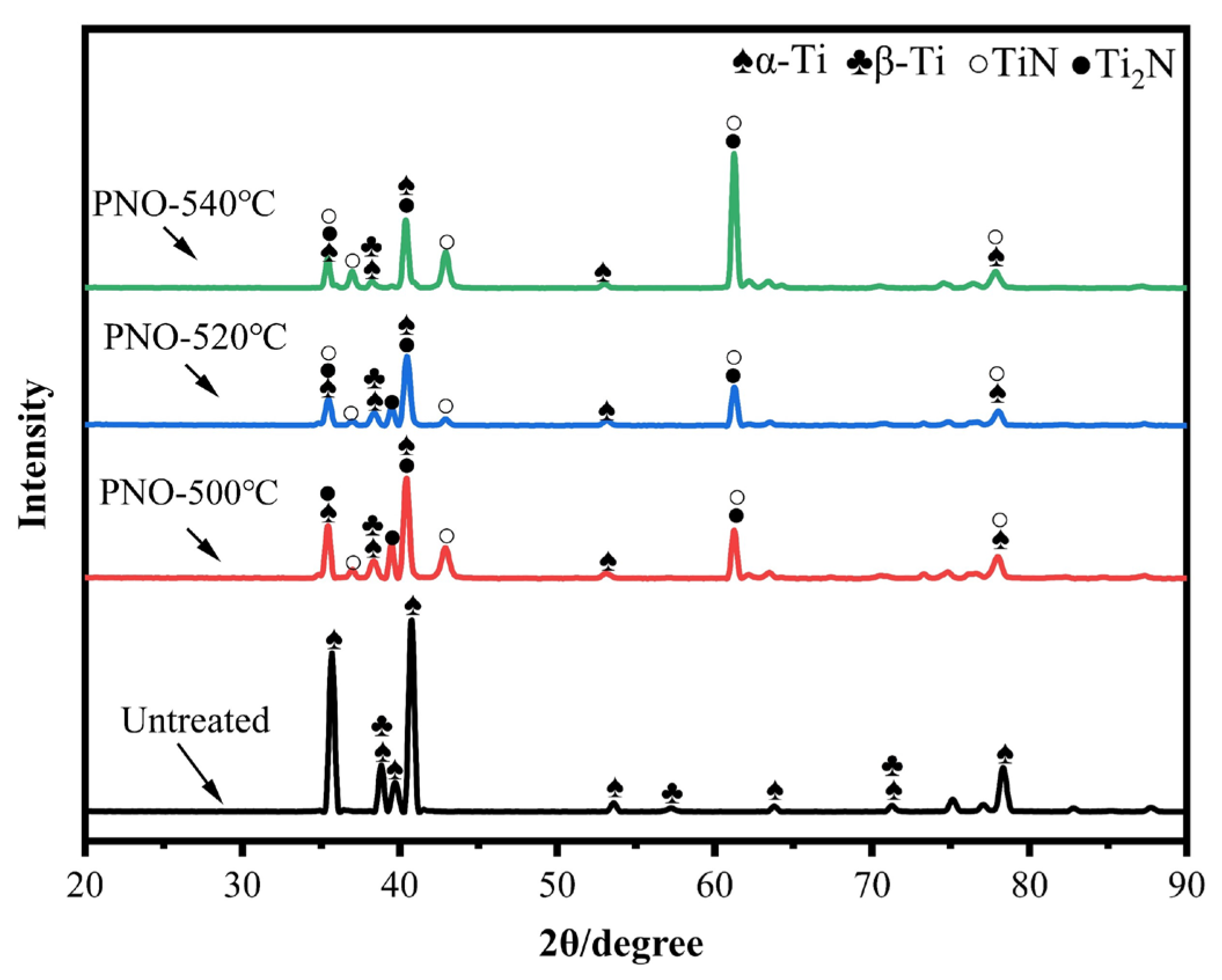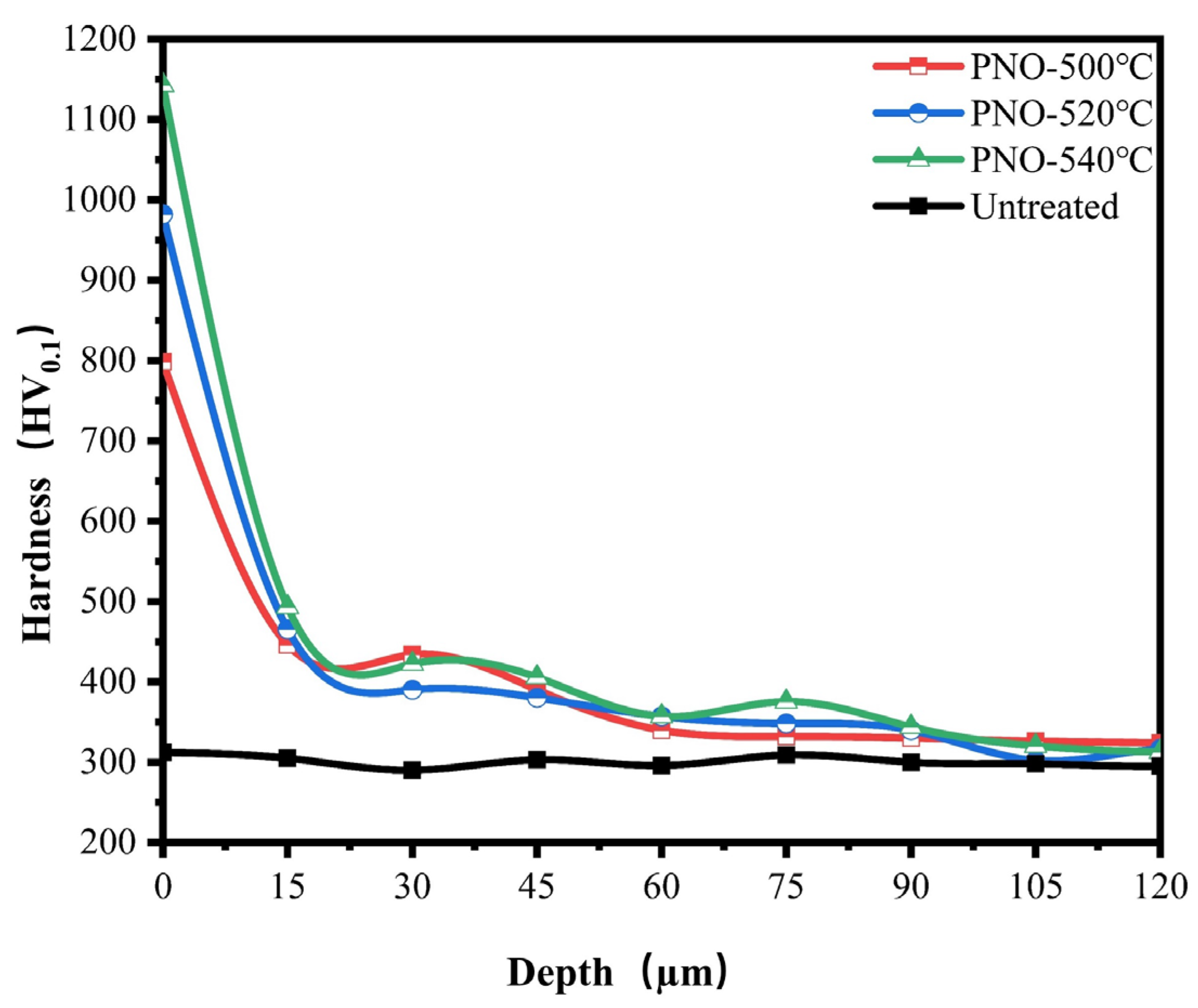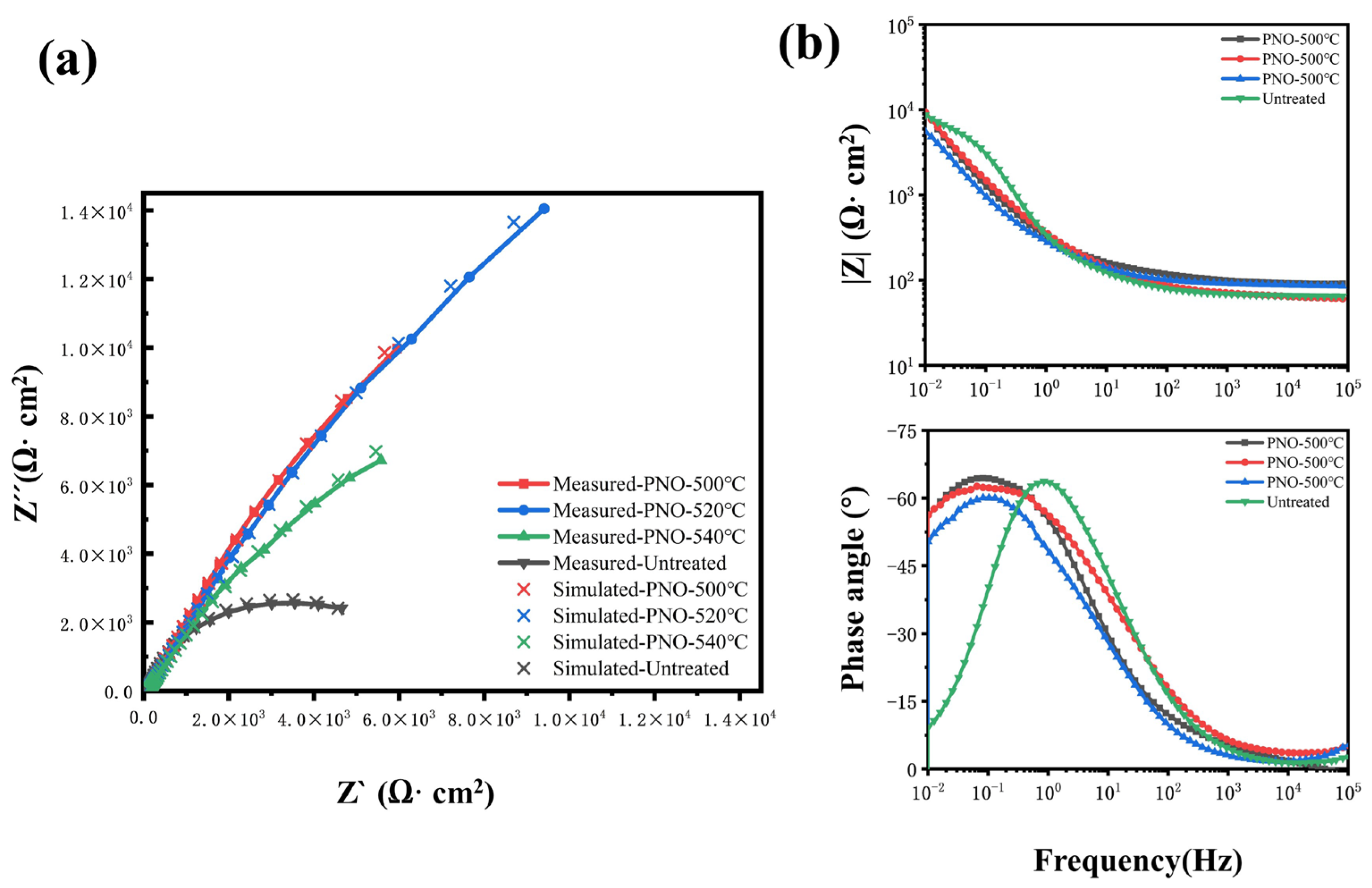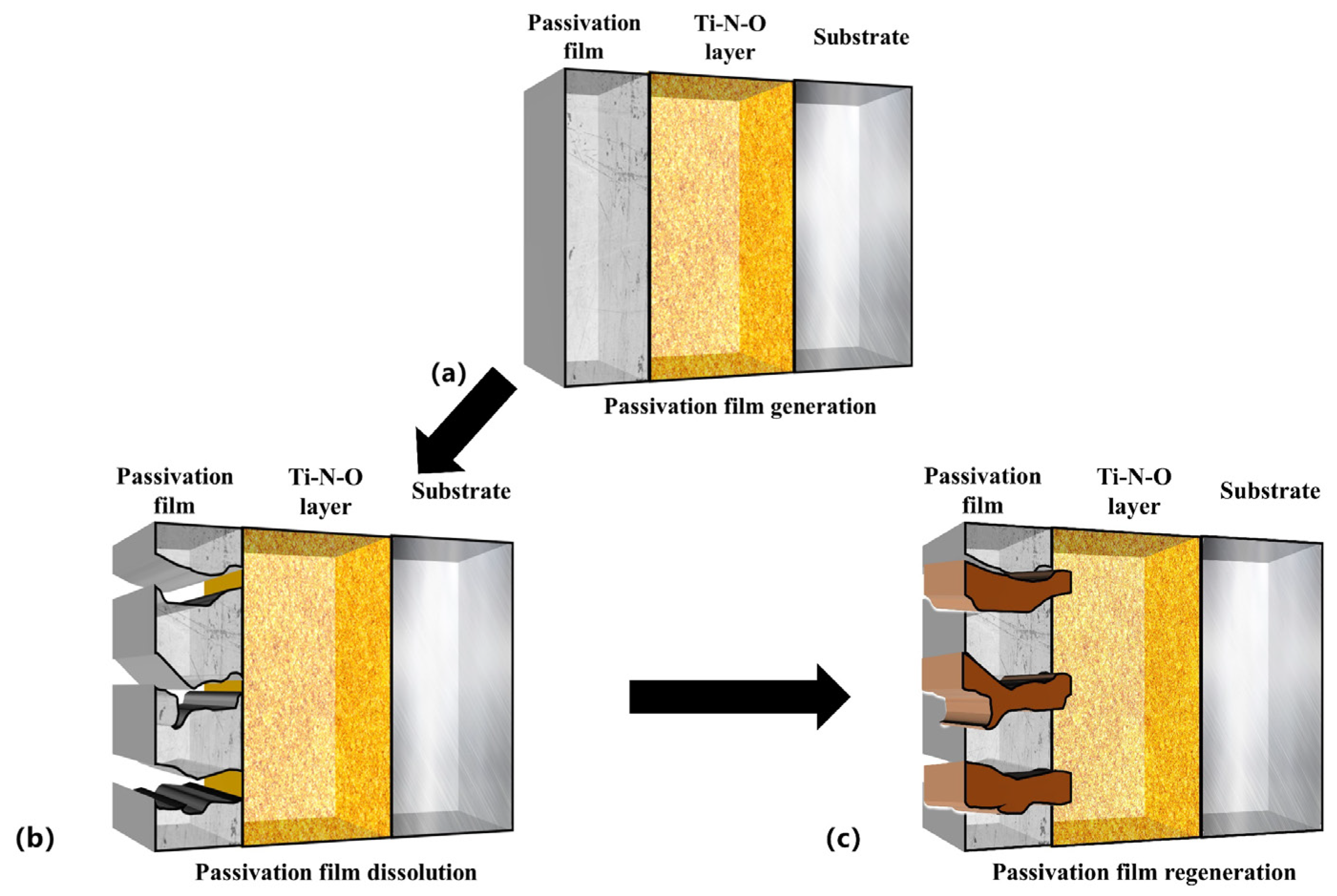Electrochemical Corrosion Behavior of Ti-N-O Modified Layer on the TC4 Titanium Alloy Prepared by Hollow Cathodic Plasma Source Oxynitriding
Abstract
1. Introduction
2. Materials and Methods
2.1. Preparation of Ti-N-O Compound Layer
2.2. Performance Test and Organization Observation
3. Results and Analysis
3.1. Analysis of Organization and Physical Structure
3.1.1. The Thickness of The Composite Layer of The PNO Samples
3.1.2. Phase Determination
3.1.3. XPS Analysis of PNO-520 Samples before Artificial Saliva Corrosion
3.2. Analysis of Mechanical Properties
3.3. Analysis of Corrosion Resistance Properties
3.3.1. Analysis of Polarization Curves
3.3.2. XPS Analysis of PNO-520 Samples after Artificial Saliva Corrosion
3.3.3. Electrochemical Impedance Spectroscopy Analysis of Different Samples
3.3.4. The Mechanism of The Unique Repassivation Process Phenomenon in PNO Samples
4. Conclusions
Author Contributions
Funding
Institutional Review Board Statement
Informed Consent Statement
Data Availability Statement
Conflicts of Interest
References
- Siony, N.; Vuong, L.; Lundaajamts, O.; Kadkhodaei, S. Computational design of corrosion-resistant and wear-resistant titanium alloys for orthopedic implants. Mater. Today Commun. 2022, 33, 104465. [Google Scholar] [CrossRef]
- Gurel, S.; Yagci, M.B.; Bal, B.; Canadinc, D. Corrosion behavior of novel Titanium-based high entropy alloys designed for medical implants. Mater. Chem. Phys. 2020, 254, 123377. [Google Scholar] [CrossRef]
- Omarov, S.; Nauryz, N.; Talamona, D.; Perveen, A. Surface Modification Techniques for Metallic Biomedical Alloys: A Concise Review. Metals 2022, 13, 82. [Google Scholar] [CrossRef]
- Krishnan, V.; Krishnan, A.; Remya, R.; Ravikumar, K.K.; Nair, S.A.; Shibli, S.M.; Varma, H.K.; Sukumaran, K.; Kumar, K.J. Development and evaluation of two PVD-coated beta-titanium orthodontic archwires for fluoride-induced corrosion protection. Acta Biomater 2011, 7, 1913–1927. [Google Scholar] [CrossRef]
- Atapour, M.; Pilchak, A.L.; Shamanian, M.; Fathi, M.H. Corrosion behavior of Ti–8Al–1Mo–1V alloy compared to Ti–6Al–4V. Mater. Des. 2011, 32, 1692–1696. [Google Scholar] [CrossRef]
- Lario, J.; Vicente Escuder, Á.; Segovia, F.; Amigó, V. Electrochemical corrosion behavior of Ti–35Nb–7Zr–5Ta powder metallurgic alloys after Hot Isostatic Process in fluorinated artificial saliva. J. Mater. Res. Technol. 2022, 16, 1435–1444. [Google Scholar] [CrossRef]
- Yu, F.; Addison, O.; Davenport, A. Temperature-Dependence Corrosion Behavior of Ti6Al4V in the Presence of HCl. Front. Mater. 2022, 9, 880702. [Google Scholar] [CrossRef]
- Pohrelyuk, I.M.; Fedirko, V.M.; Tkachuk, O.V.; Proskurnyak, R.V. Corrosion resistance of Ti–6Al–4V alloy with nitride coatings in Ringer’s solution. Corros. Sci. 2013, 66, 392–398. [Google Scholar] [CrossRef]
- Grigoriev, S.; Sotova, C.; Vereschaka, A.; Uglov, V.; Cherenda, N. Modifying Coatings for Medical Implants Made of Titanium Alloys. Metals 2023, 13, 718. [Google Scholar] [CrossRef]
- Naeem, M.; Awan, S.; Shafiq, M.; Raza, H.A.; Iqbal, J.; Díaz-Guillén, J.C.; Sousa, R.R.M.; Jelani, M.; Abrar, M. Wear and corrosion studies of duplex surface-treated AISI-304 steel by a combination of cathodic cage plasma nitriding and PVD-TiN coating. Ceram. Int. 2022, 48, 21473–21482. [Google Scholar] [CrossRef]
- Adachi, S.; Ueda, N. Wear and Corrosion Properties of Cold-Sprayed AISI 316L Coatings Treated by Combined Plasma Carburizing and Nitriding at Low Temperature. Coatings 2018, 8, 456. [Google Scholar] [CrossRef]
- Hoja, S.; Steinbacher, M.; Zoch, H.W. Compound layer design for deep nitrided gearings. Metals 2020, 10, 455. [Google Scholar] [CrossRef]
- Sharifahmadian, O.; Zhai, C.; Hung, J.; Shineh, G.; Stewart, C.A.C.; Fadzil, A.A.; Ionescu, M.; Gan, Y.; Wise, S.G.; Akhavan, B. Mechanically robust nitrogen-rich plasma polymers: Biofunctional interfaces for surface engineering of biomedical implants. Mater. Today Adv. 2021, 12, 100188. [Google Scholar] [CrossRef]
- Liu, J.; Liu, D.; Li, S.; Deng, Z.; Pan, Z.; Li, C.; Chen, T. The effects of graphene oxide doping on the friction and wear properties of TiN bioinert ceramic coatings prepared using wide-band laser cladding. Surf. Coat. Technol. 2023, 458, 129354. [Google Scholar] [CrossRef]
- Wang, X.; Bai, S.; Li, F.; Li, D.; Zhang, J.; Tian, M.; Zhang, Q.; Tong, Y.; Zhang, Z.; Wang, G.; et al. Effect of plasma nitriding and titanium nitride coating on the corrosion resistance of titanium. J. Prosthet. Dent. 2016, 116, 450–456. [Google Scholar] [CrossRef] [PubMed]
- Wierzchoń, T.; Czarnowska, E.; Grzonka, J.; Sowińska, A.; Tarnowski, M.; Kamiński, J.; Kulikowski, K.; Borowski, T.; Kurzydłowski, K.J. Glow discharge assisted oxynitriding process of titanium for medical application. Appl. Surf. Sci. 2015, 334, 74–79. [Google Scholar] [CrossRef]
- Behzadi, P.; Badr, M.; Zakeri, A. Duplex surface modification of pure Ti via thermal oxidation and gas nitriding: Preparation and electrochemical studies. Ceram. Int. 2022, 48, 34374–34381. [Google Scholar] [CrossRef]
- Banakh, O.; Moussa, M.; Matthey, J.; Pontearso, A.; Cattani-Lorente, M.; Sanjines, R.; Fontana, P.; Wiskott, A.; Durual, S. Sputtered titanium oxynitride coatings for endosseous applications: Physical and chemical evaluation and first bioactivity assays. Appl. Surf. Sci. 2014, 317, 986–993. [Google Scholar] [CrossRef]
- Albayrak, C.; Hacisalihoglu, I.; Vangolu, S.Y.; Alsaran, A. Tribocorrosion behavior of duplex treated pure titanium in Simulated Body Fluid. Wear 2013, 302, 1642–1648. [Google Scholar] [CrossRef]
- Zhang, C.W.; Wen, K.; Gao, Y. Columnar and nanocrystalline combined microstructure of the nitrided layer by active screen plasma nitriding on surface-nanocrystalline titanium alloy. Appl. Surf. Sci. 2023, 617, 156614. [Google Scholar] [CrossRef]
- Zhang, L.; Shao, M.H.; Wang, Z.W.; Zhang, Z.H.; He, Y.Y.; Yan, J.W.; Lu, J.P.; Qiu, J.X.; Li, Y. Comparison of tribological properties of nitrided Ti-N modified layer and deposited TiN coatings on TA2 pure titanium. Tribol. Int. 2022, 174, 107712. [Google Scholar] [CrossRef]
- de Abreu, L.H.; Naeem, M.; Monção, R.M.; Costa, T.H.C.; Díaz-Guillén, J.C.; Iqbal, J.; Sousa, R.R. The Effect of Cathodic Cage Plasma TiN Deposition on Surface Properties of Conventional Plasma Nitrided AISI-M2 Steel. Metals 2022, 12, 961. [Google Scholar] [CrossRef]
- Domínguez-Meister, S.; Ibáñez, I.; Dianova, A.; Brizuela, M.; Braceras, I. Nitriding of titanium by hollow cathode assisted active screen plasma and its electro-tribological properties. Surf. Coat. Technol. 2021, 411, 126998. [Google Scholar] [CrossRef]
- Borgioli, F.; Galvanetto, E.; Bacci, T. Surface Modification of Austenitic Stainless Steel by Means of Low Pressure Glow-Discharge Treatments with Nitrogen. Coatings 2019, 9, 604. [Google Scholar] [CrossRef]
- Adachi, S.; Yamaguchi, T.; Ueda, N. Formation and Properties of Nitrocarburizing S-Phase on AISI 316L Stainless Steel-Based WC Composite Layers by Low-Temperature Plasma Nitriding. Metals 2021, 11, 1538. [Google Scholar] [CrossRef]
- Wang, Z.W.; Li, Y.; Zhang, Z.H.; Zhang, S.Z.; Ren, P.; Qiu, J.X.; Wang, W.W.; Bi, Y.J.; He, Y.Y. Friction and wear behavior of duplex-treated AISI 316L steels by rapid plasma nitriding and (CrWAlTiSi)N ceramic coating. Results Phys. 2021, 24, 104132. [Google Scholar] [CrossRef]
- Sun, F.; Liu, X.-L.; Luo, S.-Q.; Xiang, D.-D.; Ba, D.-C.; Lin, Z.; Song, G.-Q. Duplex treatment of arc plasma nitriding and PVD TiN coating applied to dental implant screws. Surf. Coat. Technol. 2022, 439, 128449. [Google Scholar] [CrossRef]
- Li, Y.; Wang, Z.; Wang, L. Surface properties of nitrided layer on AISI 316L austenitic stainless steel produced by high temperature plasma nitriding in short time. Appl. Surf. Sci. 2014, 298, 243–250. [Google Scholar] [CrossRef]
- Cherenda, N.N.; Basalai, A.V.; Shymanski, V.I.; Uglov, V.V.; Astashynski, V.M.; Kuzmitski, A.M.; Laskovnev, A.P.; Remnev, G.E. Modification of Ti-6Al-4V alloy element and phase composition by compression plasma flows impact. Surf. Coat. Technol. 2018, 355, 148–154. [Google Scholar] [CrossRef]
- Zhao, Y.T.; Lu, M.Y.; Fan, Z.Q.; Huang, S.Q.; Huang, H. Laser deposition of wear-resistant titanium oxynitride/titanium composite coatings on Ti-6Al-4V alloy. Appl. Surf. Sci. 2020, 531, 147212. [Google Scholar] [CrossRef]
- Ye, Q.W.; Li, Y.; Zhang, M.Y.; Zhang, S.Z.; Bi, Y.J.; Gao, X.P.; He, Y.Y. Electrochemical behavior of (Cr, W, Al, Ti, Si)N multilayer coating on nitrided AISI 316L steel in natural seawater. Ceram. Int. 2020, 46, 22404–22418. [Google Scholar] [CrossRef]
- Jaeger, D.; Patscheider, J. A complete and self-consistent evaluation of XPS Spectra of TiN. J. Electron Spectrosc. Relat. Phenom. 2012, 185, 523–534. [Google Scholar] [CrossRef]
- Wang, Z.G.; Zu, X.T.; Xiang, X.; Zhu, S.; Wang, L.M. Surface modification of Ti-4Al-2V alloy by nitrogen implantation. J. Mater. Sci. 2006, 41, 3363–3367. [Google Scholar] [CrossRef]
- Li, Y.; Wang, L. Study of oxidized layer formed on aluminium alloy by plasma oxidation. Thin Solid Film. 2009, 517, 3208–3210. [Google Scholar] [CrossRef]
- Hong, X.; Feng, K.; Tan, Y.F.; Wang, X.L.; Tan, H. Effects of process parameters on microstructure and wear resistance of TiN coatings deposited on TC11 titanium alloy by electrospark deposition. Trans. Nonferrous Met. Soc. China 2017, 27, 1767–1776. [Google Scholar] [CrossRef]
- Mohammadi, M.; Akbari, A.; Warchomicka, F.; Pichon, L. Depth profiling characterization of the nitride layers on gas nitrided commercially pure titanium. Mater. Charact. 2021, 181, 111453. [Google Scholar] [CrossRef]
- Guo, Y.; Fang, Y.; Dai, G.; Sun, Z.; Wang, Y.; Yuan, Q. The effect of hydrogen treatment on microstructures evolution and mechanical properties of titanium alloy fabricated by selective laser melting. J. Alloy. Compd. 2022, 890, 161642. [Google Scholar] [CrossRef]
- Adam, D.B.; Tsai, M.-C.; Awoke, Y.A.; Huang, W.-H.; Lin, C.-H.; Alamirew, T.; Ayele, A.A.; Yang, Y.-W.; Pao, C.-W.; Su, W.-N.; et al. Engineering self-supported ruthenium-titanium alloy oxide on 3D web-like titania as iodide oxidation reaction electrocatalyst to boost hydrogen production. Appl. Catal. B Environ. 2022, 316, 121608. [Google Scholar] [CrossRef]
- Nguyen, T.L.; Tseng, C.C.; Cheng, T.C.; Nguyen, V.; Chang, Y.H. Formation and characterization of calcium phosphate ceramic coatings on Ti-6Al-4V alloy. Mater. Today Commun. 2022, 31, 103686. [Google Scholar] [CrossRef]
- Wei, Y.; Pan, Z.M.; Fu, Y.; Yu, W.; He, S.L.; Yuan, Q.Y.; Luo, H.; Li, X.G. Effect of annealing temperatures on microstructural evolution and corrosion behavior of Ti-Mo titanium alloy in hydrochloric acid. Corros. Sci. 2022, 197, 110079. [Google Scholar] [CrossRef]
- Borgioli, F. From Austenitic Stainless Steel to Expanded Austenite-S Phase: Formation, Characteristics and Properties of an Elusive Metastable Phase. Metals 2020, 10, 187. [Google Scholar] [CrossRef]
- Karimi, S.; Nickchi, T.; Alfantazi, A. Effects of bovine serum albumin on the corrosion behaviour of AISI 316L, Co–28Cr–6Mo, and Ti–6Al–4V alloys in phosphate buffered saline solutions. Corros. Sci. 2011, 53, 3262–3272. [Google Scholar] [CrossRef]
- Li, Q.; Wei, M.; Yang, J.; Zhao, Z.; Ma, J.; Liu, D.; Lan, Y. Effect of Ca addition on the microstructure, mechanical properties and corrosion rate of degradable Zn-1Mg alloys. J. Alloy. Compd. 2021, 887, 161255. [Google Scholar] [CrossRef]
- Luo, Y.; Wang, M.; Zhu, J.; Tu, J.; Jiao, S. Microstructure and Corrosion Resistance of Ti6Al4V Manufactured by Laser Powder Bed Fusion. Metals 2023, 13, 496. [Google Scholar] [CrossRef]
- Shahmohammadi, M.; Sun, Y.N.; Yuan, J.C.C.; Mathew, M.T.; Sukotjo, C.; Takoudis, C.G. In vitro corrosion behavior of coated Ti6Al4V with TiO2, ZrO2, and TiO2/ZrO2 mixed nanofilms using atomic layer deposition for dental implants. Surf. Coat. Technol. 2022, 444, 128686. [Google Scholar] [CrossRef]
- Li, Y.; Wang, Z.; Shao, M.; Zhang, Z.; Wang, C.; Yan, J.; Lu, J.; Zhang, L.; Xie, B.; He, Y.; et al. Characterization and electrochemical behavior of a multilayer-structured Ti–N layer produced by plasma nitriding of electron beam melting TC4 alloy in Hank’s solution. Vacuum 2023, 208, 111737. [Google Scholar] [CrossRef]
- Zhang, L.; Shao, M.; Zhang, Z.; Yi, X.; Yan, J.; Zhou, Z.; Fang, D.; He, Y.; Li, Y. Corrosion Behavior of Nitrided Layer of Ti6Al4V Titanium Alloy by Hollow Cathodic Plasma Source Nitriding. Materials 2023, 16, 2961. [Google Scholar] [CrossRef] [PubMed]
- She, D.S.; Yue, W.; Fu, Z.Q.; Wang, C.B.; Yang, X.K.; Liu, J.J. Effects of nitriding temperature on microstructures and vacuum tribological properties of plasma-nitrided titanium. Surf. Coat. Technol. 2015, 264, 32–40. [Google Scholar] [CrossRef]
- Bao, Y.C.; Wang, W.L.; Cui, W.F.; Qin, G.W. Corrosion resistance and antibacterial activity of Ti-N-O coatings deposited on dental titanium alloy. Surf. Coat. Technol. 2021, 419, 127296. [Google Scholar] [CrossRef]
- Du, J.W.; Chen, L.; Chen, J.; Yue, J.L. Effects of additional oxygen on the structural, mechanical, thermal, and corrosive properties of TiN coatings. Ceram. Int. 2022, 48, 14432–14441. [Google Scholar] [CrossRef]
- Subramanian, B.; Muraleedharan, C.V.; Ananthakumar, R.; Jayachandran, M. A comparative study of titanium nitride (TiN), titanium oxy nitride (TiON) and titanium aluminum nitride (TiAlN), as surface coatings for bio implants. Surf. Coat. Technol. 2011, 205, 5014–5020. [Google Scholar] [CrossRef]
- Wang, Q.; Huang, F.; Cui, Y.-T.; Yoshida, H.; Wen, L.; Jin, Y. Influences of formation potential on oxide film of TC4 in 0.5 M sulfuric acid. Appl. Surf. Sci. 2021, 544, 148888. [Google Scholar] [CrossRef]
- Rao, X.; Du, L.; Zhao, J.J.; Tan, X.D.; Fang, Y.X.; Xu, L.Q.; Zhang, Y.P. Hybrid TiO2/AgNPs/g-C3N4 nanocomposite coatings on TC4 titanium alloy for enhanced synergistic antibacterial effect under full spectrum light. J. Mater. Sci. Technol. 2022, 118, 35–43. [Google Scholar] [CrossRef]
- Hussein, M.A.; Yilbas, B.; Kumar, A.M.; Drew, R.; Al-Aqeeli, N. Influence of Laser Nitriding on the Surface and Corrosion Properties of Ti-20Nb-13Zr Alloy in Artificial Saliva for Dental Applications. J. Mater. Eng. Perform. 2018, 27, 4655–4664. [Google Scholar] [CrossRef]
- Yang, X.J.; Du, C.W.; Wan, H.X.; Liu, Z.Y.; Li, X.G. Influence of sulfides on the passivation behavior of titanium alloy TA2 in simulated seawater environments. Appl. Surf. Sci. 2018, 458, 198–209. [Google Scholar] [CrossRef]
- Borgioli, F.; Galvanetto, E.; Bacci, T. Surface Modification of a Nickel-Free Austenitic Stainless Steel by Low-Temperature Nitriding. Metals 2021, 11, 1845. [Google Scholar] [CrossRef]
- Liu, C.L.; Wang, Y.J.; Wang, M.; Huang, W.J.; Chu, P.K. Electrochemical stability of TiO2 nanotubes with different diameters in artificial saliva. Surf. Coat. Technol. 2011, 206, 63–67. [Google Scholar] [CrossRef]
- Wu, J.; Li, M.; Lin, C.C.; Gao, P.F.; Zhang, R.; Li, X.; Zhang, J.X.; Cai, K.Y. Moderated crevice corrosion susceptibility of Ti6Al4V implant material due to albumin-corrosion interaction. J. Mater. Sci. Technol. 2022, 109, 209–220. [Google Scholar] [CrossRef]
- Li, J.; Bai, Y.; Fan, Z.D.; Li, S.J.; Hao, Y.L.; Yang, R.; Gao, Y.B. Effect of fluoride on the corrosion behavior of nanostructured Ti-24Nb-4Zr-8Sn alloy in acidulated artificial saliva. J. Mater. Sci. Technol. 2018, 34, 1660–1670. [Google Scholar] [CrossRef]
- Chenghao, L.; Li’nan, J.; Chuanjun, Y.; Naibao, H. Crevice Corrosion Behavior of CP Ti, Ti-6Al-4V Alloy and Ti-Ni Shape Memory Alloy in Artificial Body Fluids. Rare Met. Mater. Eng. 2015, 44, 781–785. [Google Scholar] [CrossRef]
- Mareci, D.; Chelariu, R.; Gordin, D.M.; Ungureanu, G.; Gloriant, T. Comparative corrosion study of Ti-Ta alloys for dental applications. Acta Biomater 2009, 5, 3625–3639. [Google Scholar] [CrossRef]
- Oliveira, V.M.C.A.; Aguiar, C.; Vazquez, A.M.; Robin, A.; Barboza, M.J.R. Improving corrosion resistance of Ti–6Al–4V alloy through plasma-assisted PVD deposited nitride coatings. Corros. Sci. 2014, 88, 317–327. [Google Scholar] [CrossRef]
- Azumi, K.; Seo, M. Changes in electrochemical properties of the anodic oxide film formed on titanium during potential sweep. Corros. Sci. 2001, 43, 533–546. [Google Scholar] [CrossRef]
- Shen, H.Y.; Wang, L. Corrosion resistance and electrical conductivity of plasma nitrided titanium. Int. J. Hydrog. Energy 2021, 46, 11084–11091. [Google Scholar] [CrossRef]
- Fossati, A.; Borgioli, F.; Galvanetto, E.; Bacci, T. Corrosion resistance properties of plasma nitrided Ti–6Al–4V alloy in nitric acid solutions. Corros. Sci. 2004, 46, 917–927. [Google Scholar] [CrossRef]
- Tarnowski, M.; Borowski, T.; Skrzypek, S.; Kulikowski, K.; Wierzchoń, T. Shaping the structure and properties of titanium and Ti6Al7Nb titanium alloy in low-temperature plasma nitriding processes. J. Alloy. Compd. 2021, 864, 158896. [Google Scholar] [CrossRef]
- Liu, J.M.; Lou, Y.X.; Zhang, C.; Yin, S.; Li, H.M.; Sun, D.Q.; Sun, X.H. Improved corrosion resistance and antibacterial properties of composite arch-wires by N-doped TiO2 coating. Rsc Adv. 2017, 7, 43938–43949. [Google Scholar] [CrossRef]
- Cui, W.F.; Niu, F.J.; Tan, Y.L.; Qin, G.W. Microstructure and tribocorrosion performance of nanocrystalline TiN graded coating on biomedical titanium alloy. Trans. Nonferrous Met. Soc. China 2019, 29, 1026–1035. [Google Scholar] [CrossRef]










| Sample | Temperature | Heating Time (min) | Step 1 Nitriding (min) NH3 | Step 2 Oxynitriding (min) NH3:O2 (9:1) |
|---|---|---|---|---|
| UN | - | - | - | - |
| PNO-500 | 500 °C | 120 | 60 | 10 |
| PNO-520 | 520 °C | 120 | 60 | 10 |
| PNO-540 | 540 °C | 120 | 60 | 10 |
| Na2S | Mg2P2O7 | CaCL2 | KCL | NaCL | Mucin | CO(NH2)2 | Na2HPO4 | Distilled Water |
|---|---|---|---|---|---|---|---|---|
| 0.0008 g | 0.0008 g | 0.3000 g | 0.2 g | 0.2 g | 2.0 g | 0.5 g | 0.3 g | 0.5 L |
| Sample | Ecorr (V) | Icorr (A/cm2) | Rp (Ω·cm2) |
|---|---|---|---|
| UN | −0.330 | 2.78 × 10−6 | 9.35 × 103 |
| PNO-500 | −0.294 | 1.55 × 10−6 | 1.70 × 104 |
| PNO-520 | −0.289 | 7.65 × 10−8 | 3.40 × 105 |
| PNO-540 | −0.265 | 9.35 × 10−7 | 2.78 × 104 |
| Rs (Ω·cm2) | Cf (F·cm−2) | Rf (Ω·cm2) | CPEdl (F·cm−2) | Rct (Ω·cm2) | |
|---|---|---|---|---|---|
| UN | 65.35 | 1.21 × 10−3 | 86.98 | 2.7 × 10−4 | 6.50 × 103 |
| PNO-500 | 126.5 | 4.71 × 10−4 | 8.47 × 104 | ||
| PNO-520 | 90.33 | 4.27 × 10−4 | 1.36 × 105 | ||
| PNO-540 | 92.93 | 7.09 × 10−4 | 6.18 × 104 |
Disclaimer/Publisher’s Note: The statements, opinions and data contained in all publications are solely those of the individual author(s) and contributor(s) and not of MDPI and/or the editor(s). MDPI and/or the editor(s) disclaim responsibility for any injury to people or property resulting from any ideas, methods, instructions or products referred to in the content. |
© 2023 by the authors. Licensee MDPI, Basel, Switzerland. This article is an open access article distributed under the terms and conditions of the Creative Commons Attribution (CC BY) license (https://creativecommons.org/licenses/by/4.0/).
Share and Cite
Yan, J.; Shao, M.; Zhou, Z.; Zhang, Z.; Yi, X.; Wang, M.; Wang, C.; Fang, D.; Wang, M.; Xie, B.; et al. Electrochemical Corrosion Behavior of Ti-N-O Modified Layer on the TC4 Titanium Alloy Prepared by Hollow Cathodic Plasma Source Oxynitriding. Metals 2023, 13, 1083. https://doi.org/10.3390/met13061083
Yan J, Shao M, Zhou Z, Zhang Z, Yi X, Wang M, Wang C, Fang D, Wang M, Xie B, et al. Electrochemical Corrosion Behavior of Ti-N-O Modified Layer on the TC4 Titanium Alloy Prepared by Hollow Cathodic Plasma Source Oxynitriding. Metals. 2023; 13(6):1083. https://doi.org/10.3390/met13061083
Chicago/Turabian StyleYan, Jiwen, Minghao Shao, Zelong Zhou, Zhehao Zhang, Xuening Yi, Mingjia Wang, Chengxu Wang, Dazhen Fang, Mufan Wang, Bing Xie, and et al. 2023. "Electrochemical Corrosion Behavior of Ti-N-O Modified Layer on the TC4 Titanium Alloy Prepared by Hollow Cathodic Plasma Source Oxynitriding" Metals 13, no. 6: 1083. https://doi.org/10.3390/met13061083
APA StyleYan, J., Shao, M., Zhou, Z., Zhang, Z., Yi, X., Wang, M., Wang, C., Fang, D., Wang, M., Xie, B., He, Y., & Li, Y. (2023). Electrochemical Corrosion Behavior of Ti-N-O Modified Layer on the TC4 Titanium Alloy Prepared by Hollow Cathodic Plasma Source Oxynitriding. Metals, 13(6), 1083. https://doi.org/10.3390/met13061083








